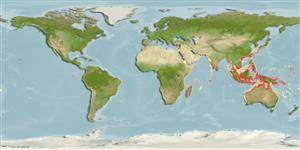Environment: milieu / climate zone / depth range / distribution range
Ecología
marino demersal. Tropical
Indo-Pacific: including the northern China Sea, Gulf of Thailand, the Philippines and southward to Indonesia, but apparently not to New Guinea and Australia; westward to Pakistan.
Tamaño / Peso / Age
Maturity: Lm ? range ? - ? cm
Max length : 10.0 cm TL macho / no sexado; (Ref. 9893); common length : 8.5 cm TL macho / no sexado; (Ref. 9893)
Inhabits shallow sand and mud bottoms in coastal waters. Feeds mainly on benthic invertebrates, especially crustaceans. Marketed fresh, frozen, and dried-salted (Ref. 9893).
Life cycle and mating behavior
Madurez | Reproducción | Puesta | Huevos | Fecundidad | Larva
Menon, A.G.K., 1984. Soleidae. In W. Fischer and G. Bianchi (eds.) FAO species identification sheets for fishery purposes. Western Indian Ocean (Fishing Area 51). Vol. 4. FAO, Rome. pag. var. (Ref. 3505)
IUCN Red List Status (Ref. 130435: Version 2024-1)
Threat to humans
Harmless
Human uses
Pesquerías: comercial
Herramientas
Special reports
Download XML
Fuentes de Internet
Estimates based on models
Preferred temperature (Ref.
123201): 25.1 - 29.1, mean 28.3 °C (based on 1008 cells).
Phylogenetic diversity index (Ref.
82804): PD
50 = 0.5020 [Uniqueness, from 0.5 = low to 2.0 = high].
Bayesian length-weight: a=0.01148 (0.00605 - 0.02179), b=3.11 (2.95 - 3.27), in cm total length, based on LWR estimates for this Genus-body shape (Ref.
93245).
Nivel trófico (Ref.
69278): 3.5 ±0.44 se; based on food items.
Resiliencia (Ref.
120179): Alto, población duplicada en un tiempo mínimo inferior a 15 meses (Preliminary K or Fecundity.).
Fishing Vulnerability (Ref.
59153): Low vulnerability (10 of 100).
